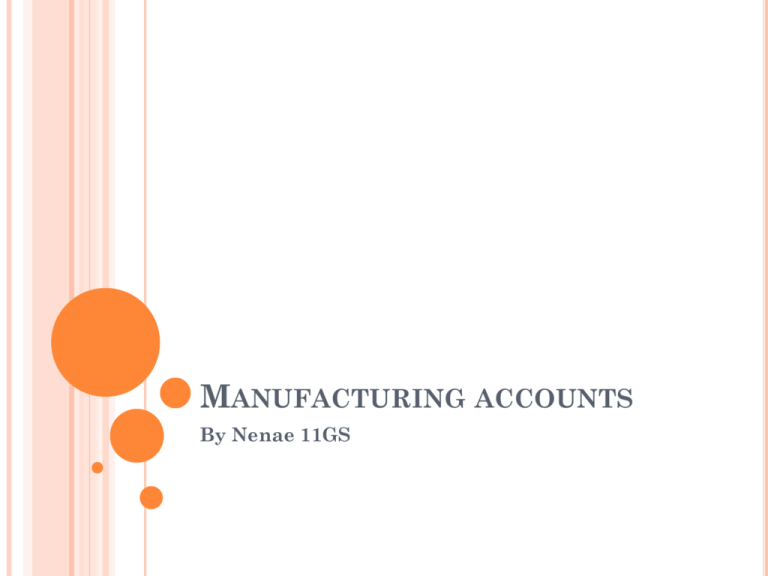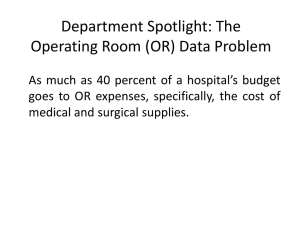Manufacturing accounts
advertisement

MANUFACTURING ACCOUNTS By Nenae 11GS WHAT IS MANUFACTURING ACCOUNT? A manufacturing account is prepared in addition to the income statement. It is produced for internal use only. People other than the owners and managers of the organisation concerned rarely see a manufacturing account. DIVISIONS OF COSTS In a manufacturing business the costs are divided into different types. Direct materials Direct labour Direct expenses Prime cost Plus Indirect manufacturing costs Plus Production cost Total cost Administration expenses Selling and distribution expenses Financial charges The prime cost item and the production cost item are shown in the manufacturing account. The administration expenses, selling and distribution expenses and financial charges appear in the income statement. DIRECT AND INDIRECT COSTS Direct costs (or prime cost) are costs that can be traced to the item being manufactured. E.g. cost of raw material including carriage inwards on those raw material, hiring of special machinery for a job. Indirect manufacturing costs (or indirect costs or sometimes known as factory overhead expenses) are those costs which occur in the factory or other place where production is being done, but which cannot easily be economically traced to the item being manufactured. E.g. wages of cleaners, rent of factory, factory power/lighting, depreciation of machinery, cost of operating forklift trucks. ADMINISTRATION EXPENSES Administration expenses consist of such items such as managers’ salaries, legal and accountancy charges, the depreciation of accounting machinery and secretarial salaries. SELLING AND DISTRIBUTION EXPENSES Selling and distribution expenses are items such as sales staff’s salaries and commission, carriage outwards, depreciation of delivery vans, advertising and display expenses. FINANCIAL CHARGES Financial charges are expense items such as bank charges and discount allowed. FROM THE EXPLANATION ABOVE, TICK IN THE APPROPRIATE COLUMN FOR EACH OF THE FOLLOWING COST… Indirect Direct Direct Direct manufacturing material labour expenses costs 1).Purchases of raw material 2).Direct wages 3).General factory expenses 4).Depreciation of machinery 5).Commission on sales 6).Factory rent 7).Carriage inwards of raw material 8).Royalties paid 9).Inventory of raw material 10).Administration salaries 11).Indirect labour 12).Bank charges 13).Carriage outwards 14).Discount allowed 15).Factory lighting Administration expenses Selling and distribution expenses Financial charges FORMAT OF FINANCIAL STATEMENTS Manufacturing account section Put into series of steps by: 1. 2. 3. 4. Add opening inventory of raw materials to purchases and subtract the closing inventory or raw material Add in all the direct costs to get the prime cost Add in all the indirect manufacturing costs. Add the opening inventory of work-in-progress and subtract the closing inventory of work-in-progress to get the production cost of all goods complete in the period. Trading account section of the income statement Includes Sales Less: COGS-Opening inventory of finished good Add: Production cost of goods complete b/d Less: Closing inventory of finished good =Gross profit Profit and Loss section of the income statement Includes: All administration expenses Add all selling and distribution expenses Add all financial charges The gross profit then subtract by the total of the calculation above. This calculation will become net profit. Example and activity for manufacturing account and income statement are provide in the manufacturing account example & activity document. (as a work sheet)



